Iran’s Gen Z movement and the hashtag wars
The hashtag #MahsaAmini has close to 300 million tweets, but who is sending the tweets?
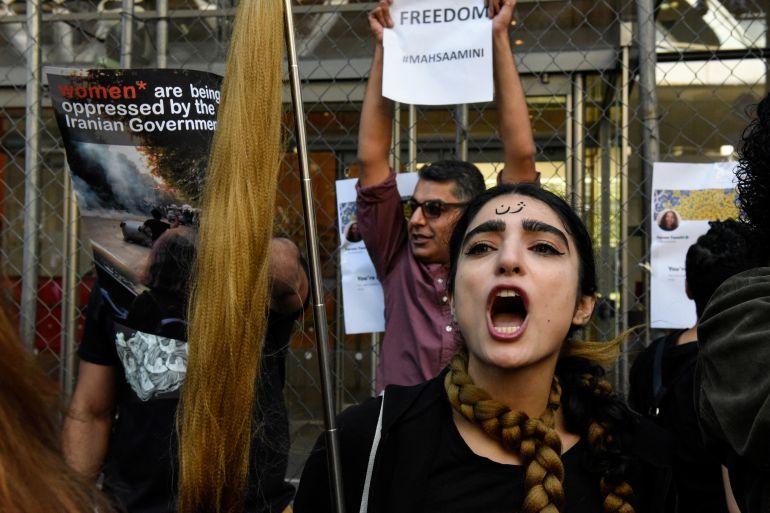
In the last month, protests in Iran have been bolder than any time since the 1979 revolution, but now, teenage girls are taking the lead. Gen Z is using their TikTok and Instagram skills to call the world’s attention to their need for freedom. But with almost three hundred hashtags, #MahsaAmini, their movement, is also being co-opted for others’ needs. So which is which?
Keep reading
list of 4 itemsDid police cause Indonesia’s football stadium disaster?
Why Burkina Faso just had its second coup in 8 months
Could Haiti get worse?
In this episode:
- Holly Dagres (@HDagres), nonresident senior fellow at the Atlantic Council and Editor, MENASource and IranSource
- Marc Owen Jones (@MarcOwenJones), assistant professor of Middle East Studies at Hamad bin Khalifa University
Connect with us:
@AJEPodcasts on Twitter, Instagram, and Facebook
Full episode transcript:
This transcript was created using AI. It has been reviewed by humans, but it might contain errors. Please let us know if you have any corrections or questions, our email is TheTake@aljazeera.net.
Halla Mohieddeen: This weekend, a fire in Iran’s notorious Evin Prison provided visual evidence that after a month of protests, Iran has not settled down.
Newsreel: Smoke was seen rising from the facility, and gunshots were heard.
Halla Mohieddeen: The Iranian government says the fire is unrelated to the protests, but for many Iranians, it’s hard to trust the government right now.
[PROTESTS SOUNDS]
Halla Mohieddeen: Meanwhile, the UK and the EU are sanctioning Iran’s morality police, and Canada’s sanctioned members of Iran’s Revolutionary Guard. When 22-year-old Mahsa Amini was killed, her image and the image of what happened to her, spread online. Now, Mahsa Amini is the most popular hashtag in the world. So what stoked the social media movement and an army of Gen Z girls in Iran? I’m Halla Mohieddeen and this is the Take.
[THEME MUSIC PLAYING]
Holly Dagres: My name is Holly Dagres. I’m a non-resident senior fellow at the Washington-based think-tank, the Atlantic Council. I’m also an Iranian American.
Halla Mohieddeen: And what Holly focuses on is social media in Iran.
Holly Dagres: Iranian social media habits and how the is Islamic republic’s repressing the online space.
Halla Mohieddeen: Before these protests broke out a month ago, Holly wrote a report, “Iranians, on hashtag social media.” It was groundbreaking.
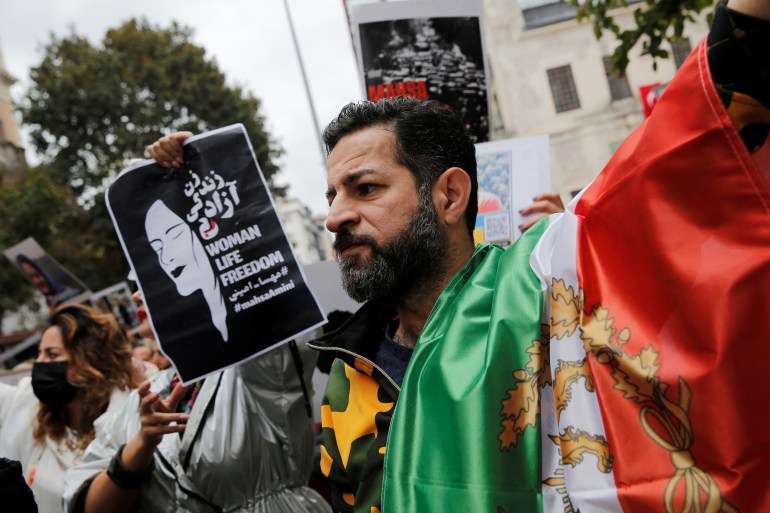
[MUSIC PLAYING]
Halla Mohieddeen: She’d been following a number of young Iranian women posting about clothes and fashion trends in Tehran. They’re like influencers everywhere, she says.
Holly Dagres: They just want the ability to be themselves like ordinary teenagers.
Halla Mohieddeen: And now, as these same women take on their government, the world is watching and asking Holly about the research she’s done.
Holly Dagres: It’s been extensively cited in the media since the protests broke out.
Halla Mohieddeen: After September 16, pictures of Mahsa Amini went viral. As Iranians responded, it was clear much of this protest movement would be happening online.
Holly Dagres: Photos of her at the ICU had gone viral with the phrase hashtag Mahsa Amini. And then the three days after that when she died, from the beating that she had endured by the so-called “morality police”, the pictures of her parents holding each other, you could see the agony.
Halla Mohieddeen: Almost immediately, protests broke out.
Holly Dagres: This story had gone so viral in the country. Even the viral video of the funeral that anger that had built up online quickly poured into the streets. In part, because Gen Z was a driving force and they were amplifying it. Videos of women starting to cut their hair had gone online, And I also saw Iranian boys on TikTok shaving their heads in solidarity as well.
Halla Mohieddeen: And now, Iranians of every age are a part of some of the most daring protests since the country’s revolution in 1979. But choosing to protest is not an easy decision. It could mean detention, prison time, and even death. Rights groups now say 240 protesters were killed by Iranian security forces, dozens of children.
[MUSIC PLAYING]
Halla Mohieddeen: Holly says she’s seen different reactions from the influencers she follows.
Holly Dagres: Some have become a little more political since the protests have broken out. Others are erring with caution. They’re not saying anything. For example, I follow an Instagram influencer and she’s still doing her thing. Her posts seem to insinuate that all things are well.
Halla Mohieddeen: That’s not the case with everyone Holly is following, though. She took a special look at Gen Z, the youngest generation now.
[MUSIC PLAYING]
Halla Mohieddeen: They’re in their tweens, teens, and early 20s.
Holly Dagres: They’re well read and articulate. Their government might be teaching them one thing at school, but thanks to the internet, they’re able to do their own research. They’re self-aware. Gen Z is a force to be reckoned with and they post vlogs about their lives. They do TikTok dance videos. They take selfies. The difference is they live in the Islamic Republic of Iran.
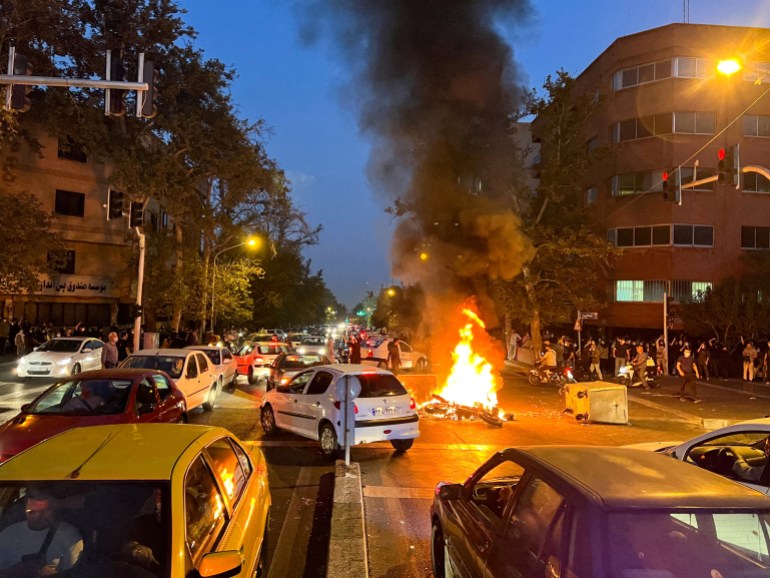
[MUSIC PLAYING]
Holly Dagres: And there are a lot of rules that could potentially get them jailed.
Halla Mohieddeen: But what Holly is so impressed by is the girls and their role in this protest movement.
Holly Dagres: What’s been so incredibly moving and fascinating to watch is just how they’ve been leading the protests. We’ve seen viral videos and images of Iranian Gen Z at school taking off their hijab, showing their hair.
Halla Mohieddeen: And making some pretty offensive hand gestures at the ubiquitous images of Supreme Leader Ayatollah Khomeni, who took hold of the country after the 1979 revolution.
Holly Dagres: Flipping the bird at the picture of the supreme leader. Flipping a bird at Islamic republic, scrawled in Persian on the blackboard. To see these kids so defiantly say that they don’t want an Islamic republic, whether it is through their actions or verbalising it in their chants. I mean, this is huge. As someone that’s grown up in Iran, I never thought I’d see that day.
Halla Mohieddeen: But in what seems to be an effort by the current Iranian government to keep these videos from circulating, they’ve shut down WhatsApp and Instagram. So you may be wondering how people are still getting on the internet. Well, the shutdown’s restrictive, but it’s not a complete blackout, Holly says.
Holly Dagres: There’s no total internet shutdown in the way that there was in November 2019.
Newsreel: This central highway in Tehran was blocked by protesters on Saturday. A day after the government raised the price of petrol by 50 percent.
Halla Mohieddeen: In 2019, protests broke out after an announcement by the Iranian government that they would be increasing the price of fuel, persistent sanctions from the United States and the west crippled Iran’s economy, separating it from much of the world and increasing fuel prices made it worse. So people took to the streets. But Holly said the government’s response to the protests was different then.
Holly Dagres: You weren’t really getting information out at all except from people that had access to a special internet that was used by universities or journalists. So, there was, straight up, a blackout and it took for a good week for footage to come out. Security forces used that internet shutdown, as a cover, to arrest and kill thousands. So, it’s interesting that we haven’t seen that total blackout in the same manner. And I think that again, has something to do with the use of the internet as a form of income and revenue.
Halla Mohieddeen: Being an internet influencer in Iran can be lucrative just like it can be almost anywhere else, but it’s not like getting on the internet is easy now.
Holly Dagres: It is very tough for Iranians to get online. I should note that 35 percent of the world’s most popular websites, including social media, websites like Twitter, YouTube, Facebook are blocked, and Iranians use circumvention tools like virtual private networks, or VPNs, to bypass this censorship.
Halla Mohieddeen: And now, Holly says, those VPNs aren’t working.
Holly Dagres: So, you’re hearing stories about people using dozens of VPNs just to get that information out to the world.
Halla Mohieddeen: And part of the reason is a new internet “protection bill.” Iran’s parliament first tried to pass it a little over a year ago.
Holly Dagres: When news broke out that they were thinking about debating it, many Iranians were outraged, it would potentially separate Iranians from the international internet that you and I use, and they would be forced to use the domestic internet. They would no longer be able to share these videos that we’re seeing coming out of the country with these protests.
Halla Mohieddeen: At the time, the bill didn’t pass, but Holly says that didn’t stop Iran’s hardline president from putting it into effect.
Holly Dagres: Since President Ibrahim Raisi took office, this bill has been secretly implemented, which is why it’s almost impossible for Iranians to get online and use VPNs.
Halla Mohieddeen: Iranian news reported the secret implementation not long before Mahsa Amini’s death. And still, despite internet restrictions, so many Iranians are getting their voices out. Thanks to a separate group of online influencers. One of the most prolific is 1,500Tasvir, which has almost a million followers on Instagram alone. Tasvir is Farsi for picture. And the number stands for the 1,500 people reportedly killed in the protests in 2019.
Holly Dagres: Their modus operandi is to highlight the situation in the country. They’re the ones that are actually documenting the photos, the videos, and amplifying them online. It’s very important. Social media is the only way for Iranians to have their voices heard by the world. And it isn’t just a news item. It’s for human rights organisations and NGOs to document the atrocities that are being committed by security forces. So that their government could be held accountable for what’s happening on the ground.
Halla Mohieddeen: Even this group, with all the images they’re putting out, Holly worries about what they’re up against.
Holly Dagres: They’re dealing with an authoritarian government and there’s only so much that they can share without getting people in trouble.
Halla Mohieddeen: But there were girls, Gen Z girls, who did get into trouble. Girls who also made their voices heard online.
Holly Dagres: Serena Esmailzadeh. She was a 16-year-old vlogger.
Halla Mohieddeen: This is Serena in one of her vlogs.
Serena Esmailzadeh: We are in need of joy and recreation. Good spirit, good vibes, good energy. In order to have these, we need freedom. This is where the conversation gets a bit dark because some of the restrictions, which are specifically put in place for a women, such as mandatory hijab, so many restrictions don’t exist for boys.
Holly Dagres: She liked to sing at the top of her lungs to Hozier’s Take me to the Church. She was beaten to death by the security forces.
Halla Mohieddeen: And then another girl, also a teen.
Holly Dagres: Nika Shakarami, also, I think 16 years old.
Halla Mohieddeen: Nika was filmed burning a scarf over a dumpster, but there are also other videos, Holly says.
Holly Dagres: Video of her just being an ordinary teenager, singing as well, doing ordinary teenage things.
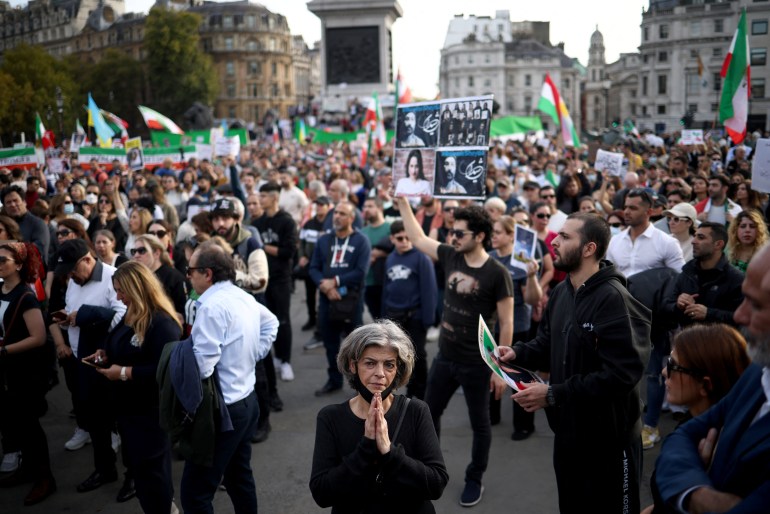
[NIKA singing]
Holly Dagres: She disappeared for days before her body was found. It’s devastating to watch, but what’s even more tragic is that they’ve also pressured her family into forced confessions on state television. It’s stories like this of Gen Z and the sacrifices that they’re willing to make. They know full well that they’ll be beaten to death by batons or shot with bullets, but they just keep moving forward and if you ask them, some of the kids that, the protesters that I’ve talked to that are Gen Z, they’ll say, “Well, every time one gets killed, more of us rise up.”
Halla Mohieddeen: The protests continue in Iran and also outside the country. After the break, how big is this social media surge? Who is driving it? And why?
[MUSIC PLAYING]
Halla Mohieddeen: As memes and protest videos pour out of Iran, women around the world are also taking to social media in solidarity. From Europe to the US to Canada, they’re cutting their hair in support.
[MUSIC PLAYING]
Newsreel: Stars like Juliet Binoche are also extending their support with this symbolic act.
Halla Mohieddeen: Holly says these acts of symbolism do a lot.
Holly Dagres: It gives them more momentum to want to keep going. Whether that will pan out, it’s really hard to say. But they really see social media as the only way to have been heard.
Halla Mohieddeen: And the numbers seem to echo that response, at least at first glance. That’s what Marc Owen Jones at Hamad Bin Khalifa University in Qatar says.
Marc Owen Jones: I am an associate professor in Middle East studies and I focus on digital disinformation on social media.
Halla Mohieddeen: Marc has figured out ways to find out if a tweet is from a person or not.
Marc Owen Jones: I develop methods to detect bots, automated accounts. And that just got me interested in finding other means of social media manipulation online.
Halla Mohieddeen: And he’s had plenty of tweets to keep him busy since the Iran protest broke out.
Marc Owen Jones: We’ve seen now 300 million tweets on the Mahsa Amini hashtag in Persian. Three hundred million for context is massive. To give some other comparisons, Black Lives Matter in a period of six years gave about 63 million tweets. The word “Ukraine”. Just the word “Ukraine” in English, since February 24, has appeared about 250 million times. So the hashtag Mahsa Amini in a period of a month has even outstriped the word “Ukraine”. The volume is just, it’s incredible and the volume itself means we need to ask questions of where those tweets are coming from. This, of course, is not a turn to dismiss any of the very real feelings and the real protests on the ground, but clearly something is going on social media that would indicate coordinated behaviour, potentially inauthentic behaviour.
Halla Mohieddeen: So, who is so tweet-happy? Where are all these tweets coming from?
Marc Owen Jones: That’s a good question. Who is tweeting these things? OK, so let’s start with the obvious one, political activists, there’s journalists, there’s real people who are politically involved using the hashtag, right? Of course, that’s happening. What’s very interesting though, is there’s the sort of unaccountable tweeting about this, fundamentally anonymous.
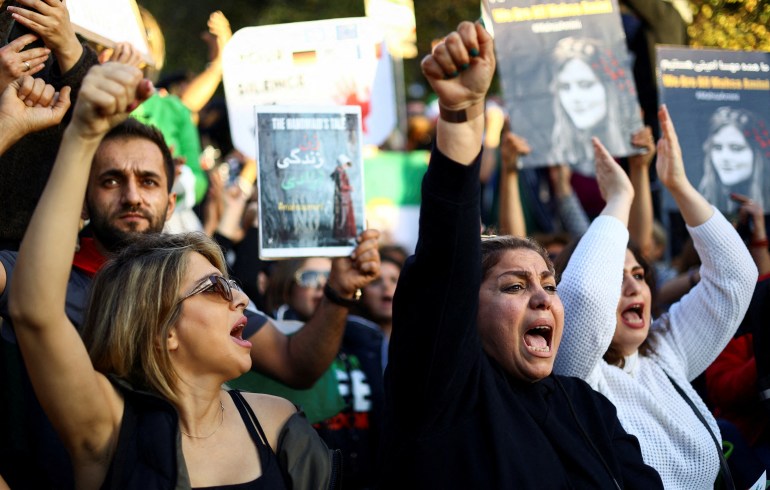
[MUSIC PLAYING]
Halla Mohieddeen: Meaning no profile picture, no location. Very hard, if not impossible to trace. And then there are groups that are a little less anonymous, but maybe a little bit more surprising.
Marc Owen Jones: The BTS army.
[DYNAMITE BY BTS PLAYING]
Marc Owen Jones: Now, please bear with me because this sounds absurd. BTS is a Korean K-pop band. Responsible, historically for creating huge Twitter storms, right? BTS and K-pop, they have a lot of followers worldwide. And they were able to mobilise supporters, in response to certain political events, usually related to social justice. So, I believe the BTS army has been activated.
Halla Mohieddeen: Fans of BTS often call themselves the BTS army.
Marc Owen Jones: So, at least, half a million tweets on the Mahsa Amini hashtag appear to be coming from BTS fan accounts.
Halla Mohieddeen: One theory for all the BTS support is that one of the Iranian teenagers who was killed, Nika Shakarami, was a huge BTS fan herself, and the BTS army are rallying around one of their own.
Marc Owen Jones: BTS has a massive following in the Middle East. It’s huge. Iran, they have a very young population, millions of BTS fans. And certainly, when Nika was killed, I saw people then attempting to call back for more BTS support because Nika was such a fan. If anything, it’s sustaining BTS’s interest in the cause.
Halla Mohieddeen: Some of the other Twitter phenomena, keeping the Mahsa Amini hashtag going, are repeats. Tweets that all say the same thing.
Marc Owen Jones: These accounts literally copy and paste identical text, like “22-year-old woman brutally killed by Iranian morality police.” There’s at least half a million of them.
[MUSIC PLAYING]
Halla Mohieddeen: And there are still other things Mark has never seen before, at least not on this scale. Just the hashtag Mahsa Amini and a number written out in Farsi.
Marc Owen Jones: And these numbers seem to go, I can’t figure out what the pattern is, but the numbers go from one to 2,000. It’s normal that people will come to Twitter and sign up accounts when there’s a political crisis, but a lot of the accounts, frankly, don’t have any clear allegiance. They’re just anti-regime; what it looks like is that someone has created a bunch of new accounts for the purpose of platform manipulation. That’s at least what I think is going on. And it implies coordination.
Halla Mohieddeen: Then, there is a whole different category of tweets and social engagement, Marc says.
[MUSIC PLAYING]
Halla Mohieddeen: There has long been a number of groups, states and actors trying to control the online narrative when it comes to the Middle East, and particularly, Iran.
Marc Owen Jones: There’s obviously a lot of people who want to exploit the situation in Iran for their own interests.
Halla Mohieddeen: One of the groups tweeting and posting in support of the protests with the hashtag Mahsa Amini is Mojahedin-e-Khalq, sometimes known as MEK. On Tuesday, October 18, one official MEK account tweeted about the protests with the hashtag Mahsa Amini and Iran Revolution 2022.
Marc Owen Jones: Some people call it a cult. Others call it a political opposition group. They were expelled from Iran for their activities.
Newsreel: They blew up parliament. They killed a number of senior Iranian officials and they had to flee.
Marc Owen Jones: And now they’re headquartered in Albania. So, the members, they were forced to sit in front of computers all day and engage on social media, creating multiple accounts
Halla Mohieddeen: MEK is focused on one thing, regime change in Iran, and the government still considers MEK a “terrorist group”. For years, they were also listed as a terrorist group in the US. But were later delisted as they found allies among US politicians. They were particularly popular with associates of US President Donald Trump.
Marc Owen Jones: John Bolton Trump’s national security advisoer, historically, he was always considered close to the MEK. And it was seeing that Bolton was in favour of having someone like the MEK be the kind of ideal replacements for the current regime. And we’ve seen even Trump, retweeting MEK-connected accounts.
Halla Mohieddeen: One of those accounts was from this Twitter farm in Albania.
Newsreel: Heshmat Alavi a self-described human rights and political activist with 30,000 followers on Twitter.
Marc Owen Jones: Which was found out to be an MEK account, run by three different people at least. It wasn’t actually a person that existed, although it was using a single avatar.
Halla Mohieddeen: It was embarrassing that the Trump administration was hoodwinked into believing this group of coordinated tweeters was a real activist, proposing a credible alternative to the government of Iran. But the group is still active. Still bent on regime change and has now latched onto Mahsa Amini. Marc says the Trump episode is a reminder of how dangerous and deceptive social media can be.
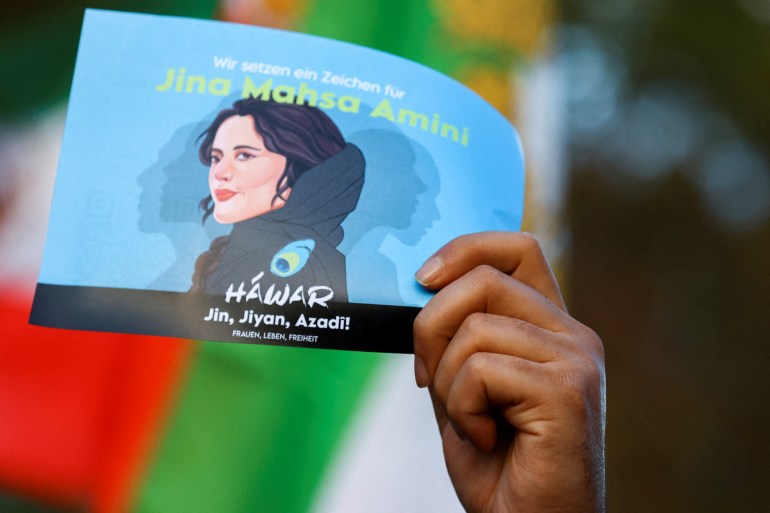
[MUSIC PLAYING]
Marc Owen Jones: If someone tweets something who’s high up or authority like the president, it’s already an indicator that they have the ear of someone influential. Also then, has this corollary thing, where, in theory, could make Trump supporters pressuring their congresspeople to support regime change in Iran. There’s a cyclical effect in potential, in theory. And this is the whole point of social media. This is why influence is targeted – to try and create this kind of public pressure.
Halla Mohieddeen: And other groups, Marc says, are taking a leaf out of the same book.
Marc Owen Jones: We also know from documents leaked about two years ago that the Iran Disinfo Project, which is essentially a project set up by the US State Department, was essentially funding this kind of propaganda campaign, but they were closed down after it was found out that they had people attacking US citizens on Twitter, for not being, basically maximalist in their position of Iran. In the past five years, we’ve seen lots of anti-Iranian propaganda coming out of Saudi Arabia and the United Arab Emirates, so it’s very possible that they’re also engaged in relentless tweeting on these hashtags. And one of the most influential people I’ve seen emerge out of this is a Jerusalem Post journalist using this hashtag and using the Iran protest as a stick to beat Palestinian opposition groups, and Iranian-linked groups, Hezbollah with.
Halla Mohieddeen: At least one of these tweets was retweeted more than 10,000 times.
Marc Owen Jones: The fact that you have, like, loads of people retweeting these Israeli accounts is quite interesting, given the context. I think at the minute, the enemy of my enemy is my friend. So, these Israeli accounts are really trying to put them on the side of ,in this case, Iranian women. And journalists seen as previously sympathetic to the Iranian regime are being attacked quite a lot. And also, there’s a US-based NGO called the National Iranian American Council. One of the things they were trying to do, I suppose, was encourage the JCPOA agreement, seen as important in reducing sanctions. But it’s also become a lightning rod and a lot of the Israeli accounts, who were also attacking this, you know, there’s been some pretty horrific stuff out there, to be honest. And I think what’s really important to remember is that so much of the information coming out on Twitter or otherwise, you need to approach it critically because people with different interests are all exploiting the situation.
[MUSIC PLAYING]
Halla Mohieddeen: And Holly agrees one should tread lightly, but she doesn’t want potential supporters to be scared off.
Holly Dagres: I think the most simple thing is, to follow the right people online.
Halla Mohieddeen: We’re only a few weeks into these protests, she says.
Holly Dagres: You don’t have millions of people out in the streets yet. The Iranian people don’t need scepticism. I think they just need our support right now. Draw attention to what’s happening in their country, and let them decide their fate and what they want to do.
Halla Mohieddeen: And that’s The Take. This episode was produced by Amy Walters with Negin Owliaei. Chloe K Li, Alexandra Locke, Ruby Zaman. Ashish Malhotra, and me Halla Mohieddeen. Alex Roldan is our sound designer, Tim St Clair mixed today’s episode. Aya Elmileik and Adam Abou-Gad are our engagement producers. Nate Alvarez is our head of audio. We’ll be back on Friday.
Episode credits:
This episode was produced by Amy Walters (Lead Prod) with Negin Owliaei, Chloe K. Li, Alexandra Locke, Ruby Zaman, Ashish Malhotra, and our host, Halla Mohieddeen. Ruby Zaman fact-checked this episode. Our production team includes Chloe K. Li, Alexandra Locke, Ashish Malhotra, Negin Owliaei, Amy Walters, and Ruby Zaman. Our sound designer is Alex Roldan. Tim St Clair mixed this episode. Aya Elmileik and Adam Abou-Gad are our engagement producers. Ney Alvarez is Al Jazeera’s head of audio.